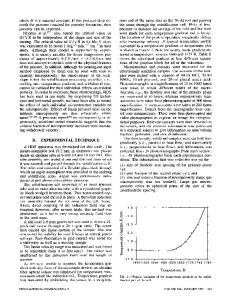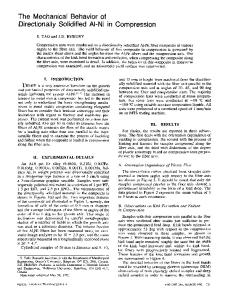Effect of Multi-Scale Thermoelectric Magnetic Convection on Solidification Microstructure in Directionally Solidified Al
- PDF / 25,916,615 Bytes
- 17 Pages / 593.972 x 792 pts Page_size
- 81 Downloads / 290 Views
ys have been widely utilized in many applications such as construction, aerospace, and automotive applications due to their unique combination of mechanical properties. The main exceptional property of these alloys is their light weight, and along with specific strength and toughness, it makes aluminum alloys good candidate materials for many applications.[1] The final properties of a cast aluminum alloy depend on the final microstructure and defects that develop during solidification. Therefore, the effect of the external conditions on the solidification microstructure of Al-based alloys has been widely investigated.[2–4] The modification of the solidification microstructure of Al-based alloys under the magnetic field has received a significant amount of research.[5–8] Recent research has revealed that the application of a magnetic field during directional solidification induces thermoelectric mag-
XI LI, Professor, is with the Department of Material Science and Engineering, Shanghai University, Shanghai 200072, P.R. China, and also with the SIMAP-EPM-Madylam/CNRS, ENSHMG BP 38402 St Martin d’Heres Cedex, France. Contact e-mail: [email protected] DAFAN DU, Doctoral Student, and ZHONGMING REN, Professor, are with the Department of Material Science and Engineering, Shanghai University, YVES FAUTRELLE, Professor, and RENE MOREAU, Professor, are with the SIMAP-EPM-Madylam/CNRS, ENSHMG. Manuscript submitted October 30, 2013. METALLURGICAL AND MATERIALS TRANSACTIONS A
netic convection (TEMC), which significantly affects the solidification structure in Al-Cu alloy.[8] Nevertheless, the real effect of the multi-scale TEMC on the macrosegregation and the dendritic network is not completely understood or quantified. Moreover, fluid flow drastically modifies the species transport in the mushy zone, where the permeability to flow varies with the solid fraction, and thus temperature, from nearly infinite permeability at the tip to zero permeability at the root. Mass transport, however, determines how the dendrite morphology develops. Although a huge amount of research has been devoted to describing the mush, or more generally, the porous body permeability, flow, and mass transport therein,[9–17] many open questions remain.[9] Therefore, it is valuable to investigate the multi-scale TEMC and deepen our mechanistic understanding of the effect of multi-scale convection on the solidification microstructure. The aim of this work is twofold: on one hand, the multi-scale TEMC and its effect on the solidification structure in Al-Si alloys are investigated; on another hand, by studying the influence of the multi-scale TEMC on the solidification structure, the understanding on the effect of the multi-scale convection on the solidification structure may be extended and deepened.
II.
EXPERIMENTAL
The Al-7 wt pct Si and Al-7 wt pct Si-1 wt pct Fe alloys were solidified directionally in the vertical configuration under a lower transverse magnetic field. Cast samples were enveloped in tubes of high-purity
corundum with an inner diameter of 3 mm and a length of 200 mm for











